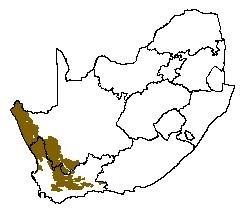THE SUCCULENT KAROO BIOME
The Succulent Karoo Biome has an equal status to the other biomes in South Africa - it is not a subtype of "a Karoo Biome". Most of the biome covers a flat to gently undulating plain, with some hilly and "broken" veld, mostly situated to the west and south of the escarpment, and north of the Cape Fold Belt. The altitude is mostly below 800 m, but in the east it may reach 1 500 m. A variety of geological units occur in the region. There is little difference between the soils of the Succulent Karoo and Nama Karoo Biomes - both are lime-rich, weakly developed soils on rock. The Olifants and Doring Rivers are the major drainage systems in the west, with the Gouritz River in the south-east of the biome. The Succulent Karoo Biome is primarily determined by the presence of low winter rainfall and extreme summer aridity. Rainfall varies between 20 and 290 mm per year. Because the rains are cyclonic, and not due to thunder-storms, the erosive power is far less than in the summer rainfall biomes. During summer, temperatures in excess of 40C are common. Fog is common nearer the coast. Frost is infrequent. Desiccating, hot, Berg Winds may occur throughout the year.
The vegetation is dominated by dwarf, succulent shrubs, of which the Vygies (Mesembryanthemaceae) and Stonecrops (Crassulaceae) are particularly prominent. Mass flowering displays of annuals (mainly Daisies - Asteraceae) occur in spring, often on degraded or fallow lands. Grasses are rare, except in some sandy areas, and are of the C3 type. The number of plant species mostly succulents - is very high and unparalleled elsewhere in the world for an arid area of this size. The bulb flora is also extremely rich.
Little data are available for the fauna of the Succulent Karoo. Of importance in the area are "heuweltjies", raised mounds of calcium-rich soil, thought to have been created by termites. These often support distinctive plant communities. The area is a known centre of richness and speciation in solitary bees (including Oil Bees (Melittidae)), scorpions and Monkey Beetles (Hopliinae).
The area has little agricultural potential due to the lack of water. The paucity of grasses limits grazing, and the low carrying capacity requires extensive supplementary feeds. Much soil has been lost from the biome, through sheet erosion, as a consequence of nearly 200 years of grazing. Ostrich farming, with considerable supplementary feeding, is practised in the Little Karoo in the south of the biome. In areas adjoining the Fynbos Biome, wine grapes, fruit and other crops are cultivated using the Fynbos water catchments. Tourism is a major industry: both the coastal scenery and the spring mass flower displays are draw cards. Mining is important, especially in the north.
Less than 0.5% of the area of the Succulent Karoo Biome has been formally conserved. The biome has a high number of rare and Red Data Book plant species. The high species richness and unique global status of the biome require urgent conservation attention. Fortunately, there, are few invasive alien plants, with only RooikransAcacia cyclops a major problem in the southern coastal regions. Strip-mining for diamonds is destructive in the northern coastal regions, and legislation requiring revegetation of these areas is inadequate for near-desert conditions.
It has been proposed that the two very species rich and endemic biomes (Succulent Karoo and Fynbos) be amalgamated into a super-biome: the Winter-rainfall Biome. The logic is that during wet phases the Fynbos expands and the Succulent Karoo fragments and speciates, and during dry phases the Fynbos fragments and speciates and the Succulent Karoo expands. This cycle has driven species formation in the region, and with the lack of glaciations or extreme climatic changes historically no major extinction spasms have occurred.



